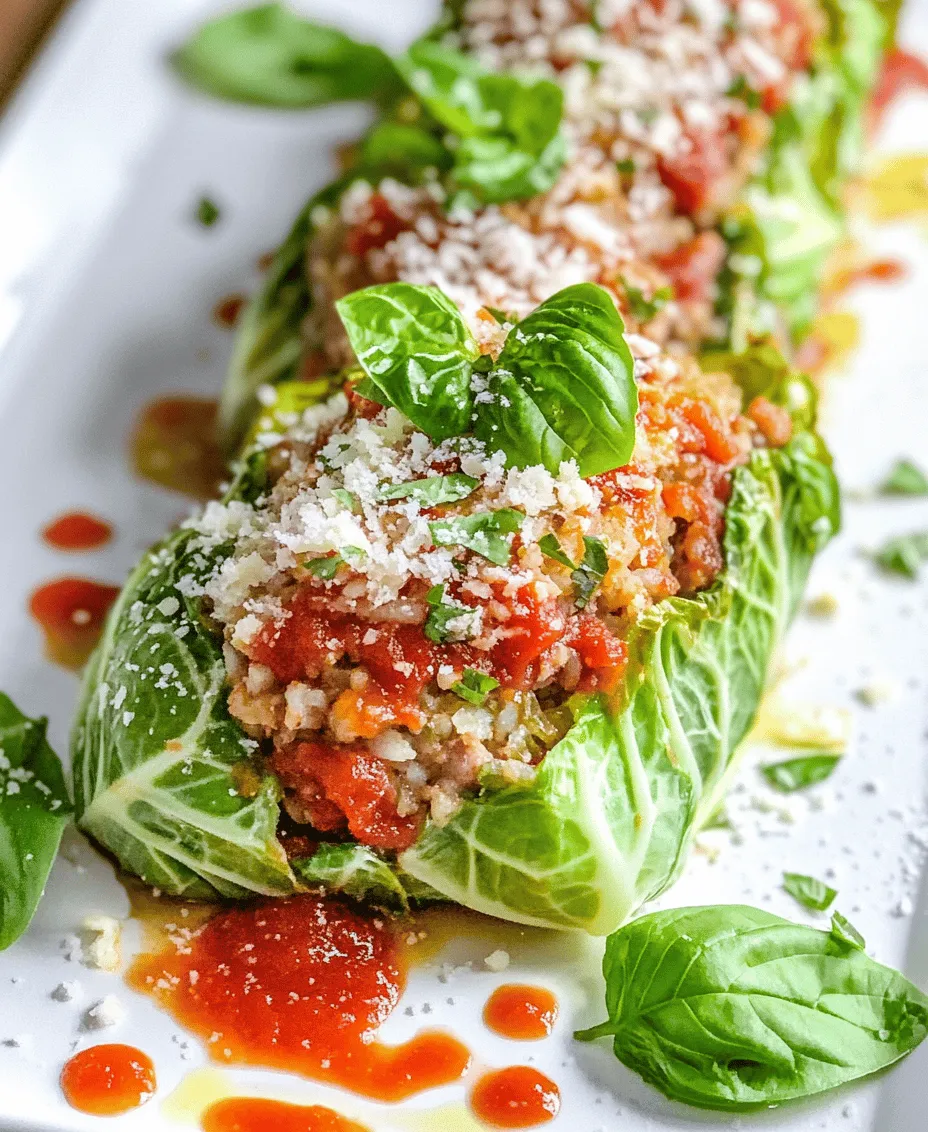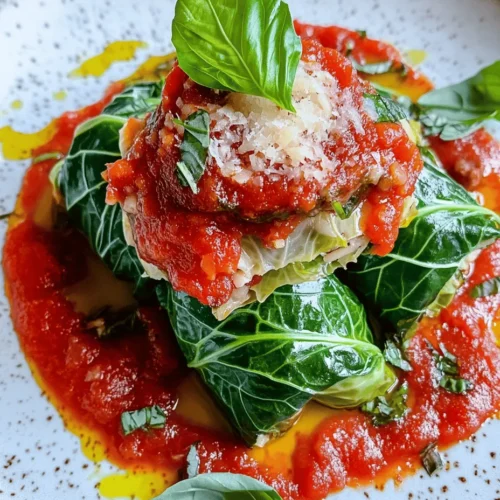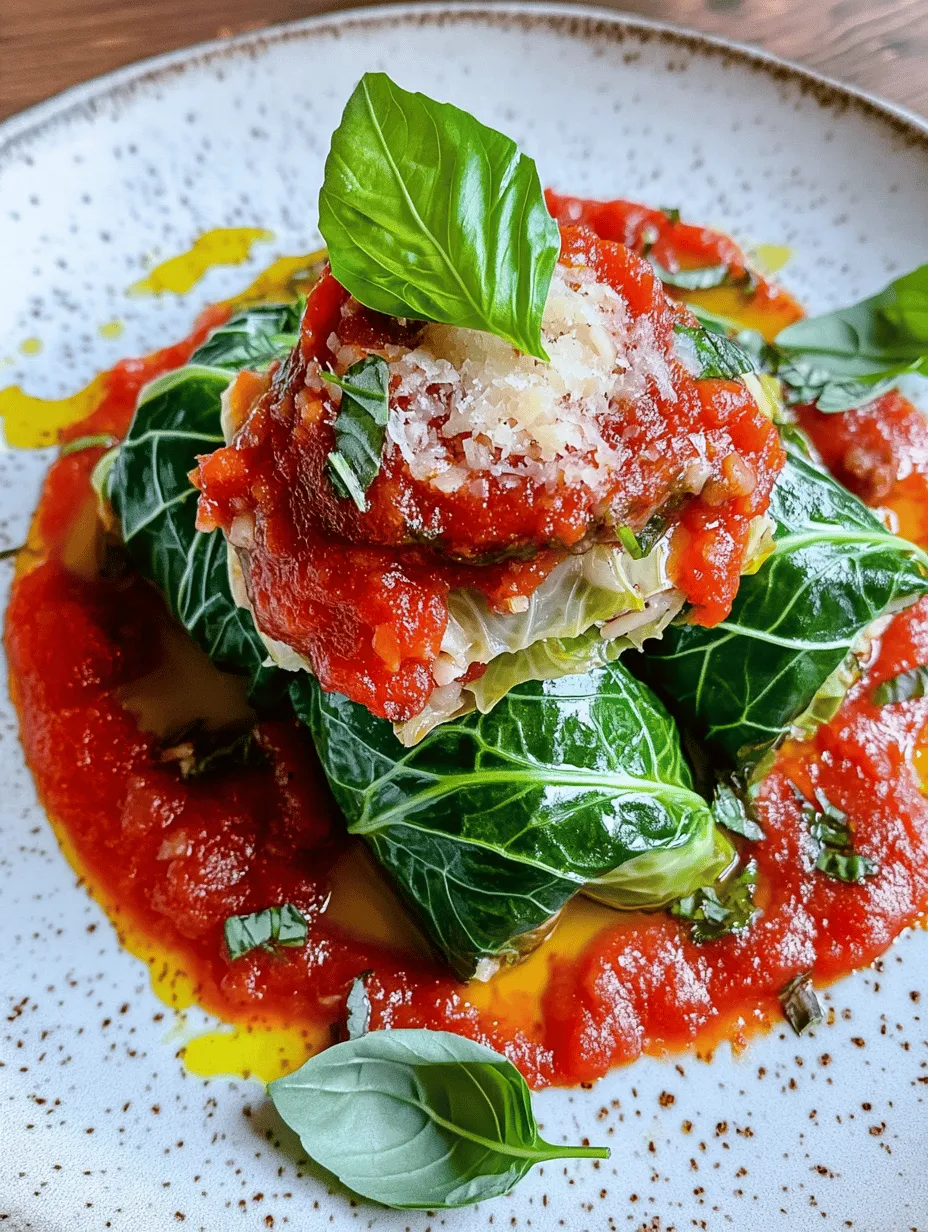Introduction to Italian Stuffed Cabbage Rolls
Exploring the rich tapestry of Italian cuisine often leads us to delightful dishes that embody both tradition and comfort. Among these, Italian Stuffed Cabbage Rolls stand out as a hearty and flavorful option that brings warmth to any dining table. These rolls, filled with a savory mixture of Italian sausage, rice, and aromatic herbs, are not just a meal; they are a celebration of family gatherings and culinary heritage.
Originating from the Italian regions, stuffed cabbage rolls offer a unique take on a dish that has transcended borders and embraced various cultural influences. While cabbage rolls are known in many cuisines around the world, the Italian version infuses a distinctive flair through the use of regional ingredients and traditional techniques. The combination of tender cabbage leaves enveloping a rich filling makes for a visually appealing and satisfying dish that is perfect for any occasion.
Whether you are preparing a family meal, hosting a cozy dinner with friends, or looking to impress guests with your culinary skills, these Italian Stuffed Cabbage Rolls are sure to leave a lasting impression. In this article, we will delve into the preparation, ingredients, and cultural significance of this beloved recipe, guiding you through each step to ensure your rolls are as delicious as they are beautiful.
Understanding the Ingredients
The Foundation of Italian Stuffed Cabbage Rolls
To create the perfect Italian Stuffed Cabbage Rolls, understanding the ingredients is crucial. Each component plays a significant role in achieving the dish’s signature flavor and texture.
Overview of Cabbage: Nutritional Benefits and Varieties
Cabbage is the star ingredient in this recipe, known for its versatility and nutritional benefits. This leafy vegetable is low in calories but high in vitamins C and K, fiber, and antioxidants, making it a healthy choice for any meal. When selecting cabbage for your rolls, look for heads that are firm, heavy, and free of blemishes.
While green cabbage is the most commonly used variety, you may also explore savoy cabbage, which has a milder flavor and more tender leaves, making it easier to roll. Napa cabbage, with its delicate texture, is another excellent alternative that adds a unique twist to the dish.
Importance of Italian Sausage: Flavor Profiles and Types (Mild vs. Spicy)
Italian sausage is essential to the filling of the cabbage rolls, providing a depth of flavor that is hard to replicate. The choice of sausage can significantly impact the overall taste of the dish. Mild Italian sausage typically contains a blend of pork, fennel seeds, and other spices, offering a savory yet gentle flavor. On the other hand, spicy Italian sausage introduces a kick with the addition of crushed red pepper flakes, making it ideal for those who enjoy a bit of heat.
When selecting your sausage, consider the flavor profile you wish to achieve. Mixing both mild and spicy sausages can create a balanced filling that caters to a variety of palates.
Role of Rice: Why Arborio is Preferred for Texture
Rice serves as a binding agent in the filling, adding texture and substance. Arborio rice, commonly used in risottos, is preferred for this recipe due to its high starch content, which creates a creamy consistency when cooked. This creaminess enhances the overall mouthfeel of the cabbage rolls, making each bite satisfying.
If Arborio rice is not available, you can substitute it with other short-grain rice varieties, though the texture may vary slightly. Always ensure the rice is thoroughly cooked before combining it with the other filling ingredients to avoid any unpleasant crunch.
Significance of Cheese: The Creamy Addition of Parmesan
No Italian dish is complete without cheese, and for stuffed cabbage rolls, freshly grated Parmesan cheese is the ideal choice. Parmesan adds a rich, nutty flavor that enhances the filling and complements the herbs and spices. When mixing the filling, be generous with the cheese to achieve a creamy texture that melds beautifully with the other ingredients.
For a more decadent option, consider adding a blend of cheeses, such as mozzarella or ricotta, to create a luscious filling that melts in your mouth.
Marinara Sauce: Homemade vs. Store-Bought Options
The sauce is the finishing touch that brings the entire dish together. A rich marinara sauce, whether homemade or store-bought, adds moisture and flavor to the cabbage rolls while enhancing their visual appeal.
For a homemade option, simmer crushed tomatoes with garlic, onions, and Italian herbs such as oregano and basil for a robust sauce that elevates your dish. However, if time is of the essence, high-quality store-bought marinara can also yield delicious results. Look for sauces made with natural ingredients and minimal preservatives to ensure the best flavor.
Fresh Herbs: The Impact of Parsley and Basil on Flavor
Fresh herbs play a vital role in Italian cuisine, and for stuffed cabbage rolls, parsley and basil are essential for adding brightness and complexity to the filling. Fresh parsley provides a mild, peppery flavor that balances the richness of the sausage and cheese, while basil contributes a sweet, aromatic quality that is synonymous with Italian dishes.
When preparing your filling, chop the herbs finely and mix them in thoroughly to ensure their flavor is evenly distributed throughout the rolls. For an added layer of flavor, consider garnishing the finished dish with additional fresh herbs before serving.
Preparation Techniques
Preparing the Cabbage for Stuffing
Before you can assemble your cabbage rolls, the cabbage leaves must be prepared properly to ensure they are pliable and easy to work with.
Boiling Water Method: Step-by-Step Guide for Blanching Cabbage Leaves
1. Select Your Cabbage: Choose a head of cabbage that is firm and heavy. Remove any wilted or damaged outer leaves.
2. Prepare the Pot: Bring a large pot of water to a rolling boil. You can add a pinch of salt to the water, which helps to season the cabbage as it cooks.
3. Core the Cabbage: Carefully remove the core of the cabbage using a sharp knife. This will make it easier to peel the leaves away.
4. Blanch the Leaves: Once the water is boiling, carefully place the whole head of cabbage in the pot. Blanch for about 2-3 minutes, or until the outer leaves begin to soften.
5. Remove the Leaves: Using tongs, carefully remove the cabbage from the pot and place it in a large bowl of ice water to stop the cooking process. This will help preserve the vibrant green color and maintain some crunch.
6. Peel the Leaves: Once cooled, gently peel away the leaves one by one. If the inner leaves are still too firm, return the cabbage to the boiling water for an additional minute before trying again.
7. Trim the Leaves: If necessary, trim the thick vein at the base of each leaf to make them more pliable for rolling.
Tips for Handling Cabbage: Avoiding Tearing and Maximizing Leaf Use
– Be Gentle: Cabbage leaves are delicate, so handle them with care to avoid tearing.
– Use the Outer Leaves First: Start with the outermost leaves, as they are more tender and easier to roll.
– Save the Inner Leaves: If you have smaller or damaged leaves, consider using them in soups or salads rather than discarding them.
Creating the Filling
Once your cabbage leaves are prepared, it’s time to create the flavorful filling that will bring your rolls to life.
Combining Ingredients: Best Practices for Mixing Sausage, Rice, and Seasonings
1. Cook the Rice: Begin by cooking your Arborio rice according to package instructions. Allow it to cool slightly before mixing it with the other ingredients.
2. Cook the Sausage: In a skillet over medium heat, cook the Italian sausage until browned and cooked through. Break it apart with a spoon as it cooks to ensure even browning. Drain excess fat if necessary and let it cool.
3. Mix the Filling: In a large mixing bowl, combine the cooked rice, sausage, grated Parmesan cheese, chopped parsley, and basil. Add any desired seasonings, such as salt, pepper, garlic powder, or crushed red pepper flakes for added heat.
4. Taste and Adjust: Before assembling the rolls, taste the filling to ensure the flavors are balanced. Adjust seasonings as needed, keeping in mind that the flavors will meld together during cooking.
Balancing Flavors: Adjusting Spices and Herbs to Taste
Cooking is an art, and every cook has their own preferences. Experiment with the amounts of herbs and spices to find the perfect balance for your taste buds. If you enjoy a strong herb flavor, consider increasing the parsley and basil. For a spicier kick, add more crushed red pepper or try incorporating Italian herbs like oregano or thyme.
As you mix your filling, remember that the quality of your ingredients will shine through in the final dish. Opt for fresh herbs, good-quality sausage, and freshly grated cheese for the best results.
Assembling the Cabbage Rolls
The art of rolling the cabbage rolls is where your hard work will come together into a beautiful dish.
The Art of Rolling
1. Prepare Your Workspace: Lay out your prepared cabbage leaves and filling mixture on a clean surface.
2. Fill the Leaves: Take a cabbage leaf and place 2-3 tablespoons of filling at the base of the leaf, keeping it centered.
3. Roll Tightly: Fold the sides of the leaf over the filling, then roll from the base to the tip, ensuring the filling is securely enclosed. The tighter you roll, the better the stuffing will stay inside while cooking.
4. Repeat: Continue this process until all the filling is used.
5. Arrange in Sauce: Place the cabbage rolls seam-side down in a baking dish lined with marinara sauce. This will prevent them from sticking and add moisture during cooking.
As you assemble, remember that practice makes perfect. If your first few rolls don’t look perfect, don’t worry! They will still taste delicious.
Stay tuned for the next part, where we will cover the cooking methods and final presentation of your Italian Stuffed Cabbage Rolls, ensuring a delightful dining experience that captures the essence of Italian comfort food.

Step-by-Step Assembly: Visualizing the Rolling Technique for Secure Stuffing
Assembling your Italian Stuffed Cabbage Rolls requires a bit of technique, but with a little practice, you’ll master the art of rolling. Start by carefully removing the cabbage leaves from the head of cabbage. Choose the largest leaves that are still intact; these will provide the best canvas for your filling.
1. Prepare the Cabbage Leaves: Boil the cabbage for about 2-3 minutes until the leaves become pliable. This will make them easier to roll without tearing. Drain and let them cool slightly.
2. Add the Filling: On a flat surface, lay out a cabbage leaf with the thick stem facing you. Place about 2-3 tablespoons of your prepared filling at the base of the leaf.
3. Rolling Technique: Fold the sides of the leaf over the filling to encase it. Then, starting from the base, roll it upwards towards the tip of the leaf, making sure to keep the sides tucked in as you roll. This will create a secure bundle that holds the filling inside during cooking.
4. Secure the Rolls: If you find the leaves are not sticking well, you can use a toothpick to secure the rolls or tie them with kitchen twine. Repeat this process until all filling is used.
Common Mistakes: How to Avoid Overfilling or Improperly Rolling
One of the most common mistakes when making stuffed cabbage rolls is overfilling the leaves. It might be tempting to add more filling for a heartier dish, but overstuffed rolls can lead to tearing and spillage during cooking.
To avoid this, remember:
– Measure Your Filling: Use a tablespoon to scoop out the filling and stick to the recommended amount. The filling should be enough to fill the leaf without bulging.
– Practice Your Rolling: If your first roll doesn’t look perfect, don’t worry. Practice makes perfect! Keep your rolls tight but not overly compressed, as they need space to expand slightly during cooking.
Baking the Cabbage Rolls
Preparing for the Oven
Once all the cabbage rolls are assembled, it’s time to prepare them for baking. Preheat your oven to 350°F (175°C).
1. Layering the Sauce: The sauce is crucial for enhancing the flavor and moisture of the cabbage rolls. Start by spreading a thin layer of marinara sauce on the bottom of a baking dish. This not only prevents the rolls from sticking but also adds flavor.
2. Arrange the Rolls: Place the rolls seam-side down in the baking dish. This helps them stay closed during baking. Pack them tightly but not so much that they are crushed.
3. Cover with Sauce: Pour the remaining marinara sauce over the rolls, ensuring they are well coated. This layer of sauce keeps the rolls moist, preventing them from drying out in the oven.
Optimal Baking Techniques: Covering vs. Uncovering for Texture
Covering your baking dish with aluminum foil is essential for the first part of the baking process, as it helps to steam the rolls and cook them evenly. After about 30-40 minutes, remove the foil to allow the tops to brown slightly.
– Covering: This step is crucial for cooking the rolls through without burning the outside.
– Uncovering: After the initial steam cooking, uncover the dish for an additional 15-20 minutes. This will create a lovely golden crust on top of the sauce, enhancing both flavor and appearance.
Serving Suggestions
Presenting Italian Stuffed Cabbage Rolls
When it comes to serving your Italian Stuffed Cabbage Rolls, presentation is key. Here are some ideas to make your dish visually appealing:
– Garnishing: Sprinkle freshly chopped basil on top for a pop of color and freshness. You can also add grated Parmesan cheese or mozzarella for a creamy finish that complements the dish beautifully.
– Pairing Recommendations: Serve your cabbage rolls with a side of garlic bread or a fresh salad to balance the meal. For a complete Italian experience, consider pairing it with a glass of Chianti or a light Pinot Grigio, which can enhance the flavors of your dish.
Cultural Significance of Cabbage Rolls
Origins of Stuffed Cabbage: A Brief History Across Various Cultures
Stuffed cabbage rolls have a rich history that spans many cultures and regions. While they are often associated with Eastern European cuisine, variations can be found in Mediterranean, Middle Eastern, and Asian dishes as well. Each culture has its unique twist on the ingredients and spices used, showcasing regional flavors and culinary traditions.
Italian Variations: How This Dish Reflects Regional Culinary Traditions
In Italy, stuffed cabbage rolls (known as “cavolo ripieno”) showcase the country’s love for fresh ingredients and robust flavors. Italian versions often incorporate local meats, herbs, and cheeses, reflecting the agricultural bounty of the region. This dish not only provides nourishment but also acts as a canvas for family recipes passed down through generations, making it a beloved comfort food.
Nutritional Overview
Assessing the Health Benefits
Italian Stuffed Cabbage Rolls are not only delicious but also nutritious. They are packed with healthy ingredients that contribute to a well-balanced meal.
– Caloric Breakdown: On average, one serving (two rolls) contains approximately 300-400 calories, depending on the ingredients used. This makes it a satisfying yet light option for dinner.
– Health Benefits of Ingredients: Cabbage is a powerhouse of vitamins K and C, fiber, and antioxidants, while the lean proteins and grains in the filling provide essential nutrients that support overall health. Incorporating a variety of vegetables into the filling boosts both the nutritional value and flavor.
Conclusion: A Taste of Tradition
Italian Stuffed Cabbage Rolls are more than just a recipe; they represent a celebration of flavors, history, and culinary artistry. As you embark on this cooking journey, you will not only enjoy a delicious meal but also connect with the rich traditions of Italian cooking. The process of preparing these rolls fosters a sense of community and sharing, making it a perfect dish for family gatherings and special occasions.
By savoring every bite, you not only appreciate the labor of love that went into making them but also honor the generations that have enjoyed stuffed cabbage rolls before you. This dish is a testament to the joy of cooking and sharing food with loved ones, ensuring it remains a cherished part of your culinary repertoire. Enjoy the process, and don’t forget to pass this beloved recipe on to future generations, keeping the tradition alive.



